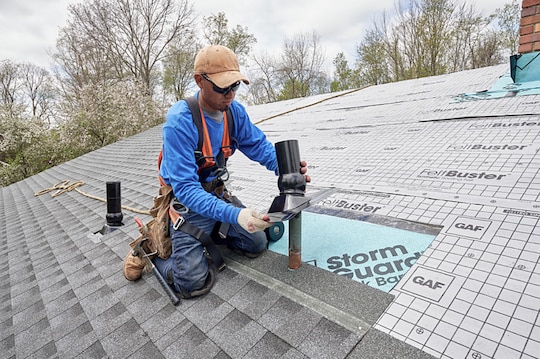
Est-ce que votre toit a une pente permettant à la pluie et à la neige fondante de s'égoutter dans des gouttières ou des avant-toits? Si oui, vous avez probablement un toit à pignon.
Bien qu'il existe un large éventail de conceptions de toit, le toit à pignon est l'un des types de toit les plus populaires, notamment en raison de sa capacité à concilier esthétique et utilité. Examinons de plus près les caractéristiques de ce type de toit.
Qu'est-ce qu'un toit à pignon?
This type of roof features two peaked sides that meet at a ridge line. The two sloping sides create end walls to form an "A" shape-a triangular extension called a gable-at the top on each end of the house. Traditionally seen in ranch-style or Cape Cod homes, gable-style roofing systems shed water well, making them one of the most popular options across North America.
How Does a Gable Roof Compare to a Hip Roof?
Both hip roofs and gable roofs are popular choices for residential homes, but they're quite different. Hip roofs slope back from all four roof sides down toward the walls of the home, which sit under the eaves. A hip roof has no vertical ends, and the "hip" is actually the angle formed where two sides meet.
With gable roofs, on the other hand, only two sides slope downward. The other two sides extend from the bottom of the eaves toward the peak of the ridge line.
What Are the Benefits of a Gable Roof?
Gable roofs provide versatility and durability that work with many styles of homes, making them a cost-effective and smart choice in most parts of the country. Because they have a simple design and their framing doesn't need to be constructed onsite, gable roofs are typically easier to install, and therefore more affordable than hip roofs. Gabled roofs also allow for more ventilation, giving homeowners more available space underneath the roof for features such as vaulted ceilings and attic space.
These types of roofs work well to shed water and snow thanks to their steep pitch, making them excellent choices for homeowners who live in areas that receive heavy snowfall. Gabled roofs also tend to provide good water drainage. The GAF lifetime roofing system is a great roofing system for your gable style roof. When you install a GAF Lifetime Shingle and at least three qualifying GAF Accessories, you get a Lifetime Limited Warranty on your qualifying GAF products.*
What Styles Do Gable Roofs Come In?
Some builders combine both hip roofs and gable roof types. What is a gable roof doing alongside elements of a hip roof? The end result often creates a more interesting design. For instance, a Dutch gable roof is a hip roof with a small gabled section on the upper section. Another variation is a half-hip roof, which adds a small hip section sloping toward the ridge onto a gable roof. Bringing elements of both types of roofs together can result in beautiful designs that offer better overall curb appeal.
There are many types of gable roofs. Most have equal-sized roof decks extending to the side walls of the house and sometimes beyond them.
- Cross-Gabled: If a home's floor plan requires a T-shaped house, the roof is cross-gabled, where two gable roof lines meet at a 90-degree angle. Houses that have garages, dormers, porches, or additions also use a cross-gable roof structure.
- Side-Gabled: Gabled roofs that show their slanting side on the front of the home are called side-gabled, while those where you see the pointed wall are called front-gabled.
- Open Gable: An open gable (or pyramid roof) consists of a hip roof on a square structure. Here, the sides all join up to form a single peak. A box gable roof features two different slopes, where the lower angle is much steeper than the higher one.
- Gambrel: Another type of gabled roof called a gambrel, or barn-style roof, features a multi-sided hip roof with two sloped sections—one flat part close to the ridge and one close to the eaves that features a sharper drop. These roofs allow for the maximum amount of usable space under the roof.
- Flying Gable Roof: A flying gable roof has a ridge overhang that extends out farther than the eave to form a point at the end of the ridge. A front gable roof is usually seen on Colonial-style homes and is placed at the front to highlight the entrance and add coverage to the porch or entryway.
What kind of gable roof does your home have? Does it provide a way to keep your home secure and boost your curbside appeal? For more inspiration, browse the GAF style guide.
*See GAF Roofing System Limited Warranty for complete coverage and restrictions. La durée de vie fait référence à la durée de la couverture de la garantie et signifie aussi longtemps que le ou les propriétaires individuels originaux d'une maison unifamiliale détachée (ou le ou les seconds propriétaires admissibles) possèdent la propriété où les produits GAF admissibles sont installés. La couverture à vie n'est pas applicable pour les autres propriétaires ou structures. Visitez gaf.com/LRS pour connaître les produits GAF admissibles. Pour les installations non admissibles à la Garantie limitée du système de toiture GAF, voir la Garantie limitée sur les bardeaux et les accessoires GAF.


